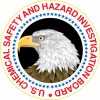The CSB is an independent federal agency charged with investigating industrial chemical accidents. Headquartered in Washington, DC, the agency’s board members are appointed by the President and confirmed by the Senate.
The CSB conducts root cause investigations of chemical accidents at fixed industrial facilities. Root causes are usually deficiencies in safety management systems, but can be any factor that would have prevented the accident if that factor had not occurred. Other accident causes often involve equipment failures, human errors, unforeseen chemical reactions or other hazards. The agency does not issue fines or citations, but does make recommendations to plants, regulatory agencies such as the Occupational Safety and Health Administration (OSHA) and the Environmental Protection Agency (EPA), industry organizations, and labor groups. Congress designed the CSB to be non-regulatory and independent of other agencies so that its investigations might, where appropriate, review the effectiveness of regulations and regulatory enforcement.
The CSB investigative staff includes chemical and mechanical engineers, industrial safety experts, and other specialists with experience in the private and public sectors. Many investigators have years of chemical industry experience.
After a CSB team reaches a chemical incident site, investigators begin their work by conducting detailed interviews of witnesses such as plant employees, managers, and neighbors. Chemical samples and equipment obtained from accident sites are sent to independent laboratories for testing. Company safety records, inventories, and operating procedures are examined as investigators seek an understanding of the circumstances of the accident.
Over a course of several months, investigators sift through evidence, consult with Board members, and review regulations and industry practices before drafting key findings, root causes and recommendations. During the process, investigators may confer with plant managers, workers, labor groups, and other government authorities. The investigative process generally takes six to twelve months to complete, and a draft report is then submitted to the Board for consideration. Reports may be adopted through a written vote of the Board or in a formal public meeting near the incident site or in Washington, DC.
In addition to investigations of specific accidents, the Board is authorized to conduct investigations of more general chemical accident hazards, whether or not an accident has already occurred. In 2002, the Board’s first hazard investigation on reactive chemicals reviewed more than 150 serious accidents involving uncontrolled chemical reactions in industry. This investigation led to new recommendations to OSHA and EPA for regulatory changes.




